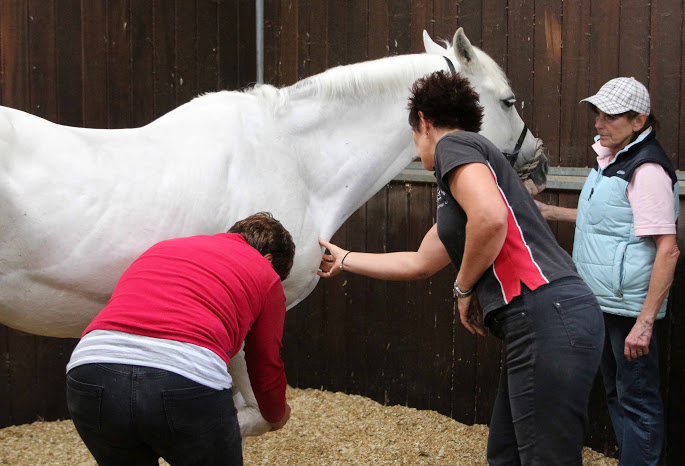
How Equine Sports Massage Can Enhance Performance and Rehabilitation in Equestrian Sports
Equine Sports Massage
Equine sports massage is a specialized form of massage therapy that focuses on improving the performance and well-being of horses involved in equestrian sports. It involves the manipulation of soft tissues, such as muscles, tendons, ligaments, and fascia, to alleviate muscle tension, reduce pain, and promote relaxation.
Benefits of Equine Sports Massage
Equine sports massage offers a wide range of benefits for horses participating in equestrian sports. These benefits include:
- Improved circulation: Massage techniques stimulate blood flow, which helps deliver oxygen and nutrients to the muscles, promoting faster recovery and enhancing performance.
- Reduced muscle tension: Massage can relieve muscle tightness and stiffness, improving flexibility and range of motion.
- Pain relief: Equine sports massage can help alleviate muscular discomfort and soreness, reducing pain and improving the horse's overall comfort.
- Enhanced performance: By addressing muscle imbalances and promoting relaxation, equine sports massage can help horses perform at their best, allowing them to reach their full potential in competition.
- Prevention of injuries: Regular massage sessions can identify areas of tightness or weakness in the muscles, helping to prevent injuries and minimize the risk of strains or sprains.
- Faster recovery: Equine massage techniques facilitate the removal of metabolic waste products from the muscles, accelerating the recovery process after intense training or competition.
Equine Sports Massage Training
Proper training is essential for individuals interested in pursuing a career in equine sports massage. The following are important aspects of equine sports massage training:
Anatomy and Physiology: A thorough understanding of equine anatomy and physiology is crucial in order to accurately assess and address muscle imbalances, injuries, and other issues that can affect a horse's performance.
Massage Techniques: Equine sports massage therapists are trained in a variety of techniques, including effleurage, petrissage, tapotement, and friction, which are used to manipulate the soft tissues and promote relaxation, pain relief, and improved circulation.
Assessment Skills: Learning how to assess a horse's musculoskeletal system is an important part of equine sports massage training. Therapists need to be able to identify areas of tension, muscle imbalances, and other issues that may be affecting the horse's performance.
Contraindications and Safety: Equine sports massage therapists must have a thorough understanding of contraindications to massage therapy and how to ensure the safety and well-being of the horse during a session.
Client Communication: Developing effective communication skills is essential for equine sports massage therapists. They need to be able to communicate with horse owners, trainers, and veterinarians to understand the horse's history, goals, and any specific areas of concern.
Continuing Education: The field of equine sports massage is constantly evolving, and it is important for therapists to stay updated with the latest research, techniques, and advancements in the field. Continuing education courses and workshops help therapists enhance their skills and knowledge.
Equine Massage Techniques
Equine sports massage therapists utilize a variety of techniques to address different issues and promote the overall well-being of the horse. Some commonly used equine massage techniques include:
Effleurage: Effleurage involves long, sweeping strokes that help warm up the muscles, increase blood flow, and promote relaxation.
Petrissage: Petrissage techniques involve kneading, squeezing, and rolling movements, which help relieve muscle tension, improve flexibility, and enhance circulation.
Tapotement: Tapotement techniques involve rhythmic tapping, hacking, and cupping movements, which help stimulate blood flow, reduce muscle tightness, and promote relaxation.
Friction: Friction techniques involve deep, circular movements that work on specific areas of muscle tension, targeting adhesions and scar tissue to promote healing and improve flexibility.
Stretching: Stretching techniques are used to increase flexibility, improve range of motion, and relieve muscle tightness. These techniques involve gentle, controlled movements that gradually lengthen the muscles.
Equine sports massage therapists have the knowledge and expertise to combine these techniques in a way that caters to the specific needs of each horse. They tailor their approach based on the horse's discipline, individual needs, and any specific issues or injuries.
Career in Equine Sports Massage
A career in equine sports massage can be a fulfilling and rewarding choice for individuals passionate about horses and their well-being. Equine sports massage therapists can work with a variety of clients, including competitive athletes, pleasure riders, and horses involved in rehabilitation programs.
To pursue a career in equine sports massage, individuals must complete a comprehensive training program from a reputable institution that covers all the necessary theoretical and practical aspects of equine massage therapy. Certification or licensure may also be required in some jurisdictions.
Equine sports massage therapists can work independently, offering their services to individual clients or partnering with equestrian centers, veterinary clinics, or rehabilitation facilities. They may also choose to specialize in a particular discipline, such as dressage, show jumping, or racing, to further enhance their knowledge and expertise.
Successful equine sports massage therapists possess excellent communication skills, as they need to effectively communicate with clients, understand their goals, and provide appropriate recommendations or advice. They also need to have a genuine love for horses and a deep understanding of their physical and emotional needs.
In conclusion, equine sports massage plays a vital role in enhancing the performance and rehabilitation of horses involved in equestrian sports. It offers numerous benefits, including improved circulation, reduced muscle tension, pain relief, enhanced performance, and prevention of injuries. To pursue a career in this field, individuals need to undergo comprehensive training, develop their assessment and massage techniques, and possess strong communication skills. Equine sports massage therapists have the unique opportunity to contribute to the well-being and success of horses in the world of equestrian sports.



























